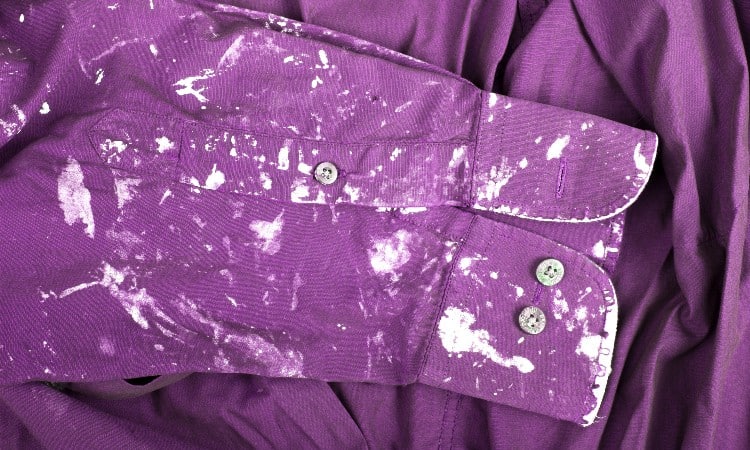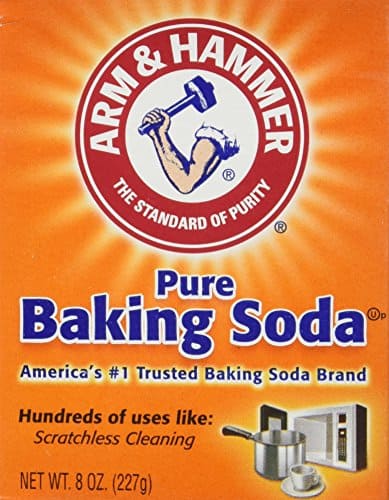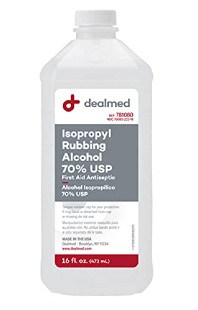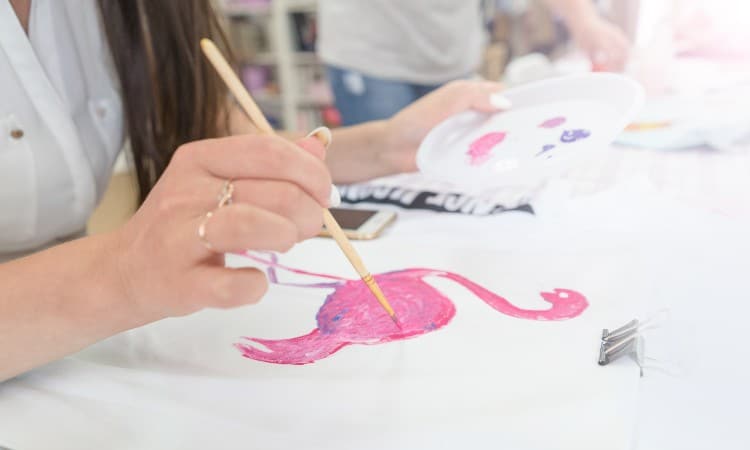Has a misfortunate fabric project led to stubborn paint stuck all over your clothes? Maybe you used fabric paints to upscale an old, bland upholstery, but the results were not up to your expectations, and you want to take off the colors now?
You are not the only one. If you think you would have to discard your favorite t-shirt because it has splotches of fabric paint that might be difficult to take off, you are mistaken.
Fabric paint does wash off clothes, depending on the type of paint used and how quickly you get to it. Ensure you follow the pretreatment steps and use the right products to treat the stain. With a bit of patience and a few handy techniques, you can remove the most indelible marks and make your clothes look as good as new.
The article will guide you on the tricks and methods to remove paint from fabric. We’ll also share insights on the most effective ingredients to get paint off your clothes.

Does Fabric Paint Wash Off Clothes?
Yes, fabric paint can be washed off clothes if certain factors are considered.
- If the fabric paint has been heat-set with an iron or similar appliances, it would be relatively more tedious to wash the colors off.
- Water-soluble paints, also known as latex paints, are easier to wash off than water-insoluble paints.
- Always attend to water-soluble paint stains once they are completely dry and oil-based paints immediately before they dry out.
- Delicate fabrics like silk are prone to get damaged if mishandled. Make sure to do a spot test to identify if the cloth fabric would be able to withstand your treatment method.
How To Get Wet Fabric Paint Out Of Clothes?
As mentioned above, if the fabric paint is water-soluble, taking it out of clothes would not be an arduous task. But, for oil-based paints, you need to be a lot more vigilant and prompt.
Before we talk in detail about the few resources you can pick up to attend to unwanted paint stains on your clothes, let us briefly discuss a few pretreatment steps and procedures.
Pretreatment
Attend to oil-based paint stains immediately that is, before they dry up.
- First, scrape out any excess paint off the fabric.
- Act fast and wash the paint off under warm, running water.
You can use a light, fabric-friendly detergent or soap to hasten the process.
Paint tends to harden and set on the fabric when treating it with heat.
Avoid doing the following until the paint stains are entirely removed from the clothes.
- Do not apply iron over the garments.
- Do not wash the garments with hot water.
- Do not use a hair-dryer or put the clothes in a dryer.
Here’s what to do to prevent the paint from bleeding or spreading to the cleaner sections of the fabric.
- Make sure to absorb all the excess, unabsorbed paint with a paper towel or blotting paper.
- Scrape it off with gentle hands, and do not rub the paint into the cloth material while you do it.
1. Baking Soda
 Baking soda is an absorbent; hence, it is efficient in removing light strokes of paint from clothes. Being a mild alkali, baking soda allows the paint to dissolve in water, resulting in its effective removal easily.
Baking soda is an absorbent; hence, it is efficient in removing light strokes of paint from clothes. Being a mild alkali, baking soda allows the paint to dissolve in water, resulting in its effective removal easily.
Baking soda gives the best results when mixed with water. One of the added benefits of treating paint stains with baking soda is it dissipates any lousy odor and soaks up all the moisture from the cloth.
If you happen to get paint on your hands, you can use baking soda to clean your hands too.
Steps to follow:
- First, blot the affected area and remove any extra paint.
- Add a cup of baking soda to some hot water.
- Soak the affected clothes in the baking water solution.
If the stain is very small, you can simply sprinkle some baking soda over the spot and let it work its magic.
2. Vinegar
 Vinegar is an inexpensive, non-toxic, natural remedy to get clean garments. It is one of the handiest ways of dealing with a paint stain on your clothes because of its ready availability. When mixed with water, vinegar releases aluminum chloride and zinc salts, which prevent the paint from sticking onto the garment.
Vinegar is an inexpensive, non-toxic, natural remedy to get clean garments. It is one of the handiest ways of dealing with a paint stain on your clothes because of its ready availability. When mixed with water, vinegar releases aluminum chloride and zinc salts, which prevent the paint from sticking onto the garment.
Vinegar is acidic and also has superb antibacterial and cleaning properties. If you add a small cup of vinegar to your water, it not only aids the cleaning process but also removes any odor that might linger from the paint. You can use all kinds of vinegar to treat your clothes with—apple cider vinegar, rice vinegar, etc.
Steps to follow:
- Mix distilled white vinegar, the best recommended out of all, with water in the ratio of 1:10.
- Use a spoon to remove any excess paint from the cloth.
- Dip a sponge into the vinegar blend.
- Using the sponge, blot the affected area until the sponge absorbs the color.
- After the paint is completely removed, wash the garment with cold water.
3. Dish Soap
Tough paint stains can also be treated with water and dish soap or laundry detergents before the color seeps deep into the fabric. Water-based paint, also known as latex paint, is best treated with dish soap. Clothes that have been subjected to acrylic or glossy paint may also be treated with a dish soap solution to remove the colors.
If you are dealing with a delicate fabric and are worried that an undiluted detergent or dish soap may be too strong for the material, you can mix the soap with some water before administering it to the stain.
Steps to follow:
- Rinse the affected fabric with water.
- Soak a sponge or a piece of rag in a dish soap and water solution.
- Soak the affected area with the solution and let it sit for a few minutes.
- Scrub and tamp down the solution into the fabric.
- Once the paint is removed, wash it with water.
4. Hairspray
You can use hairspray to remove more minor wet paint stains. The paint tends to come off fast if treated immediately. Most aerosol hairsprays, which are packed into containers with compressed gas, have alcohol as a chief constituent. This alcohol content contributes to the efficient slackening of the paint off the fabric.
The only minute drawback to using hairspray to remove paint stains is that you may have to repeat the procedure several times before achieving noticeable results.
Steps to follow:
- Spray a good amount of hairspray onto the paint stain.
- Use a laundry brush or a scrub to work the spray into the fabric.
- Excessive scrubbing will lead to the loosening of the paint.
- Once the paint is removed, make sure to run the material under some water.
5. Turpentine
Paints that have an oil base are tricky to get off your clothes. To treat them, you would require a potent substance like turpentine, a particular cleaning solvent obtained from pine trees. The effects of turpentine on stains are similar to that of commercial thinners and chemicals.
Their main function is to remove hardened paint from old painting brushes, so they work pretty well in removing wet paint paints from fabrics. The only problem with using turpentine is that it has a very strong scent that can linger on the clothes.
Steps to follow:
- Place your garment on a stack of paper towels.
- Dab the stain with a turpentine-soaked rag or sponge.
- Replace the paper towels once they are drenched with turpentine.
- Once the stain is removed, wash the cloth with some fragrant detergent to remove the odor.
6. Acetone
Acetone is a colorless, chemical solvent used to break down other substances. It is the active ingredient in nail polish removers, so you know what gives the remover its pungent smell.
If you can’t get your hands on pure acetone, you can use nail polish remover as an effective alternative. The only benefit of using the former is that it takes less time and minimal effort to remove the stains, while nail polish removers may require extra scrubbing.
Steps to follow:
- Use acetone to remove oil paints, latex-based paints, or uncured paints.
- Soak a piece of cloth, rag, or sponge in some acetone.
- Rub the stain with the rag so that the paint molecules break down and the stain disappears.
- Post treating the stain with acetone, make sure to rinse it with water and soap.
7. Rubbing Alcohol
 Rubbing alcohol is a chemical disinfectant that shows the most effective results on stained clothes. Rubbing alcohols are either ethanol-based or are isopropyl alcohol.
Rubbing alcohol is a chemical disinfectant that shows the most effective results on stained clothes. Rubbing alcohols are either ethanol-based or are isopropyl alcohol.
Besides cleaning the fabric, you can also use rubbing alcohol to disinfect the material and prevent the growth of harmful bacteria.
You can use rubbing alcohol in many ways, depending on the quality of the fabric, the severity of the stain, and prior treatments the material has been subjected to. A higher concentration of rubbing alcohol should be used on solid fabrics like denim, whereas delicate fabrics should be treated with a diluted rubbing alcohol solution.
You have to be very careful and use the right amount of alcohol on the fabric. Avoid using the solvent on any material with a risk of the fabric colors and dye coming off.
Steps To Follow:
- Damp the stained spot with some water.
- Soak an old toothbrush or cotton ball with some rubbing alcohol.
- Scrub the affected area with the solution-soaked brush or cotton ball.
- Make sure to rinse the cloth with some warm water and repeat the scrubbing until the stain comes off wholly.
- Finally, don’t forget to wash the fabric in the machine with some detergent to get rid of alcohol traces.
8. Mineral Spirits Or Paint Thinner
Mineral spirits, also known as white spirits or paint thinner, are petroleum-based products devoid of additives. They are commonly used in place of turpentines to remove oil-based paint residues off of substances and objects.
They are used for large-scale, commercial projects to clean paint rollers and brushes. The best part about mineral spirits is that they are inexpensive, and even a very small quantity of the solvent can help remove the paint spot effortlessly.
Steps to follow:
- You can use a brush, an old rag, or a sponge to apply mineral spirits.
- Dip a small part of your choice of the object in some spirit.
- Wipe the paint off with the help of the rag.
- Do not forget to clean the cloth immediately with some detergent and water so that the thinner does not remain on the fabric.
9. Professional Cleaning
When things have gotten out of hand, or you don’t have the time to rectify your mistakes, or none of the above solutions have worked in your favor, it is time to send your clothes off for professional cleaning.
Large paint deposits can be tough to get rid of at homes. Upholstery and fabrics like carpets and curtains should be sent to professional cleaners who do the job efficiently. Call your nearby cleaners before the paint leaves a permanent stain on your favorite fabric.
How to Remove Dry Fabric Paint From Clothes

Even if you are acutely careful about your painting project, a few splatters are inevitable. Dried fabric paint is a lot more challenging to remove than wet paint. Water-soluble stains must always be removed or handled once they are entirely dried up.
Here are a few successful ways to get the best and the quickest results.
Remove Dried Paint Manually
When you have no effective products nearby, it is time to put your hands to good use.
Before you embark on the task, make sure to wear protective gloves to save your skin from the hazards of the paint.
The first method is to use a metal scraper or a spoon to scrape the paint off the fabric. The only major issue with this method is that it may damage the clothes, and you may end up with a few tears if you do the scraping too vigorously.
You can use a piece of sandpaper or an electric sander to remove the dried paint spill. This is a relatively slow process, so you will have to be patient and consistent to ensure that the paint comes off ultimately.
Use A Solvent
Cleaning solvents like acetone, isopropyl alcohol, glycerin, and more are effective cleaning tools. If you have managed to get a large portion of the stain off, but a few stubborn spots just refuse to go away, using a solvent is the best way out.
You can saturate the portion that has dried paint over it with one of the solvents mentioned above. Rubbing alcohol is probably the most common and popular solvent widely applied for cleaning purposes.
You must make sure that the alcohol reaches the deepest fiber of the fabric. You can use a toothbrush dipped in some alcohol and scrub the material with it until the dried paint comes off.
Scrub The Strain With A Brush
Scrubbing the stain with a brush can be effective in its removal, but only if done correctly. When dealing with more delicate fabrics like silk, chiffon, lace, and wool, careless scrubbing will do the material no good.
Always wet the brush before application. You can dip it in a homemade cleaning solution or into any suitable cleaning solvent or bleach.
Avoid purchasing cheap brush alternatives that have low-quality bristles. Instead, invest in a better option like a natural or a velvet-faced brush.
The bristles of the brush should be stiff so that they work their way into the fabric. You can opt for a proper laundry brush for more prominent stains, while more minor stains can be treated with toothbrushes as well.
Machine Wash
After you have treated the stain with your hands and removed the residue with the help of a brush dipped in a suitable cleaning solvent, give the fabric a machine wash.
The machine wash would not just work on the leftover paint spill but would also work on removing any dirt or bacteria build-up on your clothes. Turn on the cold water setting and use a generous amount of detergent for the stain to vanish.
Make sure to check the care label on your garment to check if your cleaning method would damage the fabric. If the stain is too tough, and if the label permits, you may add a small quantity of chlorine bleach to treat the color.
Conclusion
Fabric painting is an enjoyable hobby until it ends with paint smothered all over your beautiful garments. Nevertheless, there are multiple convenient ways of getting fabric paint out of your clothes. I have mentioned some of the best ones that can come to the rescue.
We hope you consider the suggestions and this article becomes your savior in the event of a fabric emergency!
If you liked what you read, make sure to share it with your friends and family too.